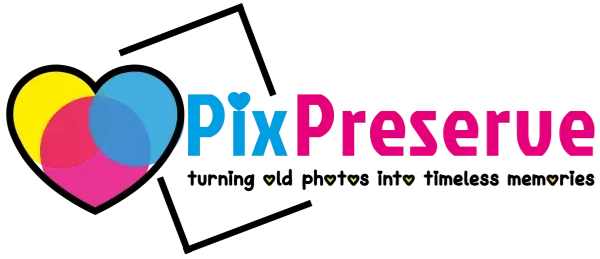
How to Safely Remove Tape, Glue, and Sticky Residue from Photo Prints
Old photo collections often come with surprises — tape marks, sticky residue, or bits of glue left behind from albums, scrapbooks, or mounting projects. These materials can damage your precious prints over time, so removing them safely is an important step before scanning or preserving your photos.
In this guide, we’ll explain how to remove tape, glue, and sticky residue from photos without causing damage — plus a few expert tips from the preservation team at PixPreserve.
Photographic prints are delicate. The paper and emulsion layers can easily tear, warp, or smear if handled improperly.
Always:
A small amount of gentle, indirect heat can soften old adhesive.
Use a hair dryer on the lowest setting, holding it about 8–10 inches away for a few seconds.
Once the glue softens, lift it carefully using tweezers or a clean cotton swab.
⚠️ Do not use heat on Polaroids, matte photos, or any print that curls easily. Heat may permanently damage them.
After removing the bulk of the tape or glue, some sticky residue may remain. To clean it:
Avoid household cleaners, rubbing alcohol, or acetone — they can remove ink, fade colors, and ruin your photo permanently.
Let the cleaned photo air dry completely on a clean, flat surface.
If it curls while drying, place it between two sheets of acid-free paper and weigh it down with a light, flat object like a book for a few hours.
Once your photos are clean and dry, it’s the perfect time to digitize them.
At PixPreserve, we professionally scan and preserve photos at high resolution so your memories are protected forever — without sticky residue or fading over time.
When you’re ready to bring your old photos back to life, PixPreserve is here to help — providing professional photo scanning and digital preservation services handled with the utmost care.
In this guide, we’ll explain how to remove tape, glue, and sticky residue from photos without causing damage — plus a few expert tips from the preservation team at PixPreserve.
💡 Before You Begin: Handle Photos with Care
Photographic prints are delicate. The paper and emulsion layers can easily tear, warp, or smear if handled improperly.Always:
- Work in a clean, dry area away from direct sunlight.
- Wash and dry your hands thoroughly or use lint-free cotton gloves.
- Test any cleaning method on a small corner or a less valuable print first.
🧴 Step 1: Gently Lift Tape or Adhesive
If the tape or glue is recent and hasn’t hardened, try slowly peeling it back using a pair of clean tweezers.- Work from the edge and move gently to avoid lifting the photo’s surface.
- Never pull quickly — this can tear the emulsion layer or leave a white scar.
🌡️ Step 2: Loosen Sticky Residue with Warm Air
A small amount of gentle, indirect heat can soften old adhesive.Use a hair dryer on the lowest setting, holding it about 8–10 inches away for a few seconds.
Once the glue softens, lift it carefully using tweezers or a clean cotton swab.
⚠️ Do not use heat on Polaroids, matte photos, or any print that curls easily. Heat may permanently damage them.
💧 Step 3: Remove Remaining Sticky Residue
After removing the bulk of the tape or glue, some sticky residue may remain. To clean it:- Lightly dampen a cotton swab with distilled water or photo-safe film cleaner.
- Gently dab (don’t rub) the sticky area.
- Use a dry microfiber cloth to blot away any excess moisture.
Avoid household cleaners, rubbing alcohol, or acetone — they can remove ink, fade colors, and ruin your photo permanently.
🧻 Step 4: Dry and Flatten the Photo
Let the cleaned photo air dry completely on a clean, flat surface.If it curls while drying, place it between two sheets of acid-free paper and weigh it down with a light, flat object like a book for a few hours.
🖼️ Step 5: Digitize for Long-Term Protection
Once your photos are clean and dry, it’s the perfect time to digitize them.At PixPreserve, we professionally scan and preserve photos at high resolution so your memories are protected forever — without sticky residue or fading over time.
🧠 Bonus Tips from the Experts at PixPreserve
- Avoid storing photos in self-stick “magnetic” albums — their adhesive backings break down and cause permanent damage.
- Always use acid-free photo sleeves or boxes.
- If the adhesive is extremely stubborn or the photo is valuable, consult a professional conservator instead of attempting removal yourself.
✅ Final Thoughts
Removing tape, glue, and sticky residue from photo prints takes time and patience, but it’s worth it to preserve your irreplaceable memories. With a gentle touch and the right approach, you can safely clean and prepare your photos for scanning and long-term storage.When you’re ready to bring your old photos back to life, PixPreserve is here to help — providing professional photo scanning and digital preservation services handled with the utmost care.
